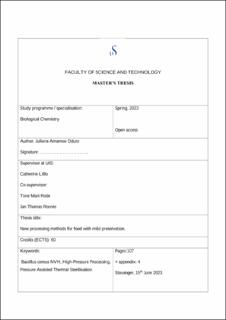| dc.description.abstract | The pathogenicity of spore-forming bacteria such as Bacillus cereus has become a global food safety concern. Unlike sterilization, bacillus spores can survive pasteurization temperatures. Conventional thermal treatments remain the major processing technique in many food industries but due to their drawbacks in reducing the taste and nutritional qualities of food, the use of non-thermal technologies such as High-Pressure Processing (HPP) has increased in recent years. The main objective of this study was to investigate the effect of thermal and pressure-thermal treatments in inhibiting B. cereus NVH 1230-88 spore and vegetative cell growth in broth and food matrices. The effect of initial bacterial numbers on the growth of B. cereus NVH vegetative cells was investigated. Higher cell numbers resulted in a faster time to detection (TTD) at OD of 0.2. The effect of preservatives (NaCl, KCl, NaNO2, and nisin) at different concentrations and pH on B. cereus NVH 1230-88 spore growth was studied. The combined effect of the preservatives on bacterial growth was also investigated. No time to detection (TTD) values were recorded at high salt concentrations of 4% and 2% (NaCl and KCl) at pH 4, illustrating the inhibitory effect of high concentrations of preservatives at lower pH. NaNO2 exhibited no inhibitory effect on the growth of B. cereus NVH 1230-88 spores. Inactivation of spores by thermal treatments at 97℃ for 5 and 10 mins in LB medium resulted in a log reduction of 3.74 and 4.10 respectively. However, under the same processing conditions, a log reduction of 3.35 log cfu/ml was achieved in minced meat. The effect of spore inactivation by HPP (600mPa) at three different processing temperatures (20, 40, and 55℃) on the B. cereus NVH spores resulted in log reductions of 0.22 cfu/ml, 1.80 cfu/ml, and 3.08 cfu/ml respectively, illustrating the synergistic effect of pressure thermal treatments in spore inactivation. HPP alone could not achieve the highest spore inactivation in minced meat. However, a synergy of pressure-thermal (HPP-55℃) treatments resulted in an increase in spore reduction in the meat matrix. High spore inactivation and log reductions were observed in meat samples treated with 1% NaCl, 500IU nisin at HPP 55℃. A similar trend was observed when a similar experiment was performed in Bioscreen. The vegetative cell growth of B. cereus NVH 1230-88 was tested at 8℃ and 15℃ with a combination of preservatives (NaCl adjusted at pH 4). Higher bacterial log numbers were recorded at 15℃ compared to 8℃ in samples with no preservatives. Bacterial log numbers declined in samples with preservatives. However, temperature and time played an important role in the extent of inhibition caused by the preservatives. | |
